An Image Matching Method for SAR Orthophotos from Adjacent Orbits in Large Area Based on SAR-Moravec
Abstract
:1. Introduction
2. Study Area and Data Selection
3. Methodology
3.1. Moravec and SAR-Moravec
3.2. Template Determining
3.3. Matching Procedure
3.4. Evaluation Criteria of Matching
- Matching efficiency: Time consumption of the whole procedure is used to indicate the matching efficiency of each method.
- Matching accuracy: To quantitatively evaluate the accuracy of matching points, the standard deviation (SD) and root mean square error (RMSE) are formulated. SD can be calculated for evaluating the average pixel error. RMSE can be calculated for measuring the alignment of all matching points. These two criteria are formulated as follows.
- 3.
- Correct ratio of matching points: The extraction of feature points is the first step in area-based matching and feature-based matching. The quality of them is one important factor of the correct ratio of matching points. To utilize this criterion, we calculate the correct matching ratio (CMR) [22] as follows.where denotes the number of correct matching points after the process of RANSAC, which we called inliers. represents the number of all matching points before RANSAC, which includes false matching points (outliers).
- 4.
- Distribution of matching points: Due to the existence of different terrain types in wide swath SAR orthophotos, the distribution of matching points is extremely impacted by the texture information. In the matching procedure of SAR-Moravec, we design the regular grid to optimize the distribution of matching points. The grid control in the SAR orthophoto can be utilized in a large area. The global distribution density (GDD) can evaluate the performance of distribution, which is formulated as follows.where represents the number of matching points in the regular grid , and denotes the mean number of matching points in all grids. is the number of regular grids in experimental data.
4. Results and Discussion
4.1. Feature Points Extraction of Moravec and SAR-Moravec
4.2. Experiment of Adaptability Compared with SAR-SIFT
4.3. Experiment of Adaptability in Different Terrain Types
4.4. Experiment of SAR Orthophoto Matching
5. Conclusions
Author Contributions
Funding
Conflicts of Interest
References
- Luscombe, A. Image quality and calibration of RADARSAT-2. In Proceedings of the 2009 IEEE International Geoscience and Remote Sensing Symposium, Cape Town, South Africa, 12–17 July 2009; pp. II-757–II-760. [Google Scholar]
- Williams, D.; LeDantec, P.; Chabot, M.; Hillman, A.; James, K.; Caves, R.; Thompson, A.; Vigneron, C.; Wu, Y. RADARSAT-2 image quality and calibration update. In Proceedings of the EUSAR 2014; 10th European Conference on Synthetic Aperture Radar, Berlin, Germany, 3–5 June 2014; pp. 1–4. [Google Scholar]
- Geudtner, D.; Torres, R.; Snoeij, P.; Davidson, M.; Rommen, B. Sentinel-1 system capabilities and applications. In Proceedings of the 2014 IEEE Geoscience and Remote Sensing Symposium, Quebec City, QC, Canada, 13–18 July 2014; pp. 1457–1460. [Google Scholar]
- Prats-Iraola, P.; Nannini, M.; Scheiber, R.; De Zan, F.; Wollstadt, S.; Minati, F.; Vecchioli, F.; Costantini, M.; Borgstrom, S.; De Martino, P. Sentinel-1 assessment of the interferometric wide-swath mode. In Proceedings of the 2015 IEEE International Geoscience and Remote Sensing Symposium (IGARSS), Milan, Italy, 26–31 July 2015; pp. 5247–5251. [Google Scholar]
- Han, B.; Zhong, L.; Liu, J.; Qiu, X.; Hu, Y.; Lei, B. SAR data processing for GF3. In Proceedings of the EUSAR 2018; 12th European Conference on Synthetic Aperture Radar, Aachen, Germany, 4–7 June 2018; pp. 1–6. [Google Scholar]
- Jiao, N.; Wang, F.; You, H.; Qiu, X.; Yang, M. Geo-Positioning Accuracy Improvement of Multi-Mode GF-3 Satellite SAR Imagery Based on Error Sources Analysis. Sensors 2018, 18, 2333. [Google Scholar] [CrossRef] [PubMed] [Green Version]
- Wulder, M.A.; White, J.C.; Fournier, R.A.; Luther, J.E.; Magnussen, S. Spatially explicit large area biomass estimation: Three approaches using forest inventory and remotely sensed imagery in a GIS. Sensors 2008, 8, 529–560. [Google Scholar] [CrossRef] [PubMed] [Green Version]
- Chang, L.; Dollevoet, R.P.; Hanssen, R.F. Nationwide railway monitoring using satellite SAR interferometry. IEEE J. Sel. Top. Appl. Earth Obs. Remote Sens. 2016, 10, 596–604. [Google Scholar] [CrossRef]
- Amitrano, D.; Di Martino, G.; Iodice, A.; Riccio, D.; Ruello, G.; Ciervo, F.; Papa, M.N.; Koussoubé, Y. Effectiveness of high-resolution SAR for water resource management in low-income semi-arid countries. Int. J. Remote Sens. 2014, 35, 70–88. [Google Scholar] [CrossRef]
- Vassilopoulou, S.; Hurni, L.; Dietrich, V.; Baltsavias, E.; Pateraki, M.; Lagios, E.; Parcharidis, I. Orthophoto generation using IKONOS imagery and high-resolution DEM: A case study on volcanic hazard monitoring of Nisyros Island (Greece). Isprsj. Photogramm. Remote Sens. 2002, 57, 24–38. [Google Scholar] [CrossRef]
- Sheng, Y.; Alsdorf, D.E. Automated georeferencing and orthorectification of Amazon basin-wide SAR mosaics using SRTM DEM data. IEEE Trans. Geosci. Remote Sens. 2005, 43, 1929–1940. [Google Scholar] [CrossRef]
- Georgopoulos, A.; Natsis, S. A simpler method for large scale digital orthophoto production. Int. Arch. Photogramm. Remote Sens. Spat. Inf. Sci. 2008, 37, 266. [Google Scholar]
- Wu, B.; Hu, H.; Guo, J. Integration of Chang’E-2 imagery and LRO laser altimeter data with a combined block adjustment for precision lunar topographic modeling. Earth Planet. Sci. Lett. 2014, 391, 1–15. [Google Scholar] [CrossRef]
- Bányai, L.; Szűcs, E.; Wesztergom, V. Data quality of sentinel-1 IW SLC images and artificial twin backscatterers designed for 3D surface change monitoring with the fusion of PSI and GNSS techologies. ESASP 2016, 740, 390. [Google Scholar]
- Bayanudin, A.A.; Jatmiko, R.H. Orthorectification of Sentinel-1 SAR (Synthetic Aperture Radar) Data in Some Parts Of South-eastern Sulawesi Using Sentinel-1 Toolbox. Iop Conf. Ser. Earth Environ. Ence 2016, 47, 012007. [Google Scholar] [CrossRef]
- Zhang, G.; Wu, Q.; Wang, T.; Zhao, R.; Deng, M.; Jiang, B.; Li, X.; Wang, H.; Zhu, Y.; Li, F. Block adjustment without GCPs for Chinese spaceborne SAR GF-3 imagery. Sensors 2018, 18, 4023. [Google Scholar] [CrossRef] [PubMed] [Green Version]
- Ghannadi, M.A.; Saadatseresht, M. A Modified Local Binary Pattern Descriptor for SAR Image Matching. IEEE Geosci. Remote Sens. Lett. 2018, 16, 568–572. [Google Scholar] [CrossRef]
- Cruz-Mota, J.; Bogdanova, I.; Paquier, B.; Bierlaire, M.; Thiran, J.-P. Scale invariant feature transform on the sphere: Theory and applications. Int. J. Comput. Vis. 2012, 98, 217–241. [Google Scholar] [CrossRef]
- Bay, H.; Ess, A.; Tuytelaars, T.; Gool, L.V. Speeded-Up Robust Features (SURF). Comput. Vis. Image Underst. 2008, 110, 346–359. [Google Scholar] [CrossRef]
- Dubois, C.; Nascetti, A.; Thiele, A.; Crespi, M.; Hinz, S. SAR-SIFT for Matching Multiple SAR Images and Radargrammetry. Pfg-J. Photogramm. Remote Sens. Geoinf. Sci. 2017, 85, 149–158. [Google Scholar] [CrossRef]
- Dellinger, F.; Delon, J.; Gousseau, Y.; Michel, J.; Tupin, F. SAR-SIFT: A sift-like algorithm for SAR images. IEEE Trans. Geosci. Remote Sens. 2014, 53, 453–466. [Google Scholar] [CrossRef] [Green Version]
- Wang, B.; Zhang, J.; Lu, L.; Huang, G.; Zhao, Z. A uniform SIFT-like algorithm for SAR image registration. IEEE Geosci. Remote Sens. Lett. 2015, 12, 1426–1430. [Google Scholar] [CrossRef]
- Zhu, H.; Ma, W.; Hou, B.; Jiao, L. SAR image registration based on multifeature detection and arborescence network matching. IEEE Geosci. Remote Sens. Lett. 2016, 13, 706–710. [Google Scholar] [CrossRef]
- Paul, S.; Pati, U.C. SAR image registration using an improved SAR-SIFT algorithm and Delaunay-Triangulation-Based local matching. IEEE J. Sel. Top. Appl. Earth Obs. Remote Sens. 2019, 12, 2958–2966. [Google Scholar] [CrossRef]
- Stephens, M.; Harris, C. 3D wire-frame integration from image sequences. Image Vis. Comput. 1989, 7, 24–30. [Google Scholar] [CrossRef]
- Qi, Z.; Ting, R.; Husheng, F.; Jinlin, Z. Particle filter object tracking based on Harris-SIFT feature matching. Procedia Eng. 2012, 29, 924–929. [Google Scholar] [CrossRef] [Green Version]
- Liu, M.; Wu, C.; Zhang, Y. Multi-resolution optical flow tracking algorithm based on multi-scale Harris corner points feature. In Proceedings of the Control and Decision Conference, Yantai, China, 2–4 July 2008. (In Chinese). [Google Scholar]
- Gundogdu, E.; Alatan, A.A. Good features to correlate for visual tracking. IEEE Trans. Image Process. 2018, 27, 2526–2540. [Google Scholar] [CrossRef] [PubMed] [Green Version]
- Changwei, C. A fast matching algorithm based on corner detection and SIFT algorithm. Comput. Appl. Softw. 2014, 31, 214–216. [Google Scholar]
- Rosten, E.; Porter, R.; Drummond, T. Faster and better: A machine learning approach to corner detection. IEEE Trans. Pattern Anal. Mach. Intell. 2008, 32, 105–119. [Google Scholar] [CrossRef] [PubMed] [Green Version]
- Yu, H.; Liu, Y.; Li, L.; Yang, W.; Liao, M. Stable feature point extraction for accurate multi-temporal SAR image registration. In Proceedings of the 2017 IEEE International Geoscience and Remote Sensing Symposium (IGARSS), Fort Worth, TX, USA, 23–28 July 2017; pp. 181–184. [Google Scholar]
- Yu, H.; Yang, W.; Liu, Y. Coarse-to-Fine Accurate Registration for Airborne SAR Images Using SAR-FAST and DSP-LATCH. Prog. Electromagn. Res. 2018, 163, 89–106. [Google Scholar] [CrossRef] [Green Version]
- Yan, L.; Huai, Y.; Wen, Y.; Li, L. SAR image registration using SAR-FAST corner detection. J. Electron. Inf. Technol. 2017, 2, 430–436. [Google Scholar]
- Al-Zaydi, Z.Q.; Ndzi, D.L.; Kamarudin, M.L.; Zakaria, A.; Shakaff, A.Y. A robust multimedia surveillance system for people counting. Multimed. Tools Appl. 2017, 76, 23777–23804. [Google Scholar] [CrossRef]
- Jiaoab, N.; Kangab, W.; Xiangab, Y.; Youab, H. A novel and fast corner detection method for sar imagery. In Proceedings of the International Archives of the Photogrammetry, Remote Sensing and Spatial Information Sciences, Wuhan, China, 18–22 September 2017. 42(2/W7). [Google Scholar]
- Xiong, W.; Tian, W.; Yang, Z.; Niu, X.; Nie, X. Improved FAST corner-detection method. J. Eng. 2019, 2019, 5493–5497. [Google Scholar] [CrossRef]
- Moravec, H.P. Robot: Mere machine to Transcendent Mind; Oxford University Press on Demand: New York, NY, USA, 2000. [Google Scholar]
- Kubica, V.; Neyt, X.; Griffiths, H.D. Validation of the increased image resolution obtained using TOPSAR sentinel-1 data in a bistatic setup. In Proceedings of the 2017 Progress in Electromagnetics Research Symposium—Fall (PIERS—FALL), Singapore, 19–22 November 2017. [Google Scholar]
- Giudici, D.; Mancon, S.; Guarnieri, A.M.; Piantanida, R.; Recchia, A. Enhanced processing of Sentinel-1 TOPSAR data. In Proceedings of the Igarss IEEE International Geoscience & Remote Sensing Symposium, Beijing, China, 10–15 July 2016. [Google Scholar]
- Li, Y.; Zhu, D. The geometric-distortion correction algorithm for circular-scanning SAR imaging. IEEE Geosci. Remote Sens. Lett. 2009, 7, 376–380. [Google Scholar]
- Nagler, T.; Rott, H.; Hetzenecker, M.; Wuite, J.; Potin, P. The Sentinel-1 Mission: New Opportunities for Ice Sheet Observations. Remote Sens. 2015, 7, 9371. [Google Scholar] [CrossRef] [Green Version]
- Gao, J.; Sun, J.Y.; Liu, J. Image matching method based on normalized grayscale variance Hausdorff distance. J. Comput. Appl. 2011, 31, 741–744. [Google Scholar] [CrossRef]
- Cheng, L.; Li, M.; Liu, Y.; Cai, W.; Chen, Y.; Yang, K. Remote sensing image matching by integrating affine invariant feature extraction and RANSAC. Comput. Electr. Eng. 2012, 38, 1023–1032. [Google Scholar] [CrossRef]
- Lin, C.; Zhou, H.-F.; Chen, W. Improved Bilateral Filtering for a Gaussian Pyramid Structure-Based Image Enhancement Algorithm. Algorithms 2019, 12, 258. [Google Scholar] [CrossRef] [Green Version]
- Shimizu, M.; Okutomi, M. Precise subpixel estimation on area-based matching. Syst. Comput. Jpn. 2002, 33, 1–10. [Google Scholar] [CrossRef]
- Molderink, A.; Bakker, V.; Bosman, M.G.; Hurink, J.L.; Smit, G.J. Management and control of domestic smart grid technology. IEEE Trans. Smart Grid 2010, 1, 109–119. [Google Scholar] [CrossRef] [Green Version]
- Daolian, Y.; Changhua, L.; Jinliang, Z.; Kai, Y.; Xiaoting, C. Edge detection in SAR images based on ROEWA and Hough transform. J. Electron. Meas. Instrum. 2013, 6, 543–548. [Google Scholar]
- Wu, B.; Zhou, S.; Ji, K. A novel method of corner detector for SAR images based on Bilateral Filter. In Proceedings of the 2016 IEEE International Geoscience and Remote Sensing Symposium (IGARSS), Beijing, China, 10–15 July 2016; pp. 2734–2737. [Google Scholar]
- Kropatsch, W.G.; Strobl, D. The generation of SAR layover and shadow maps from digital elevation models. IEEE Trans. Geosci. Remote Sens. 1990, 28, 98–107. [Google Scholar] [CrossRef]
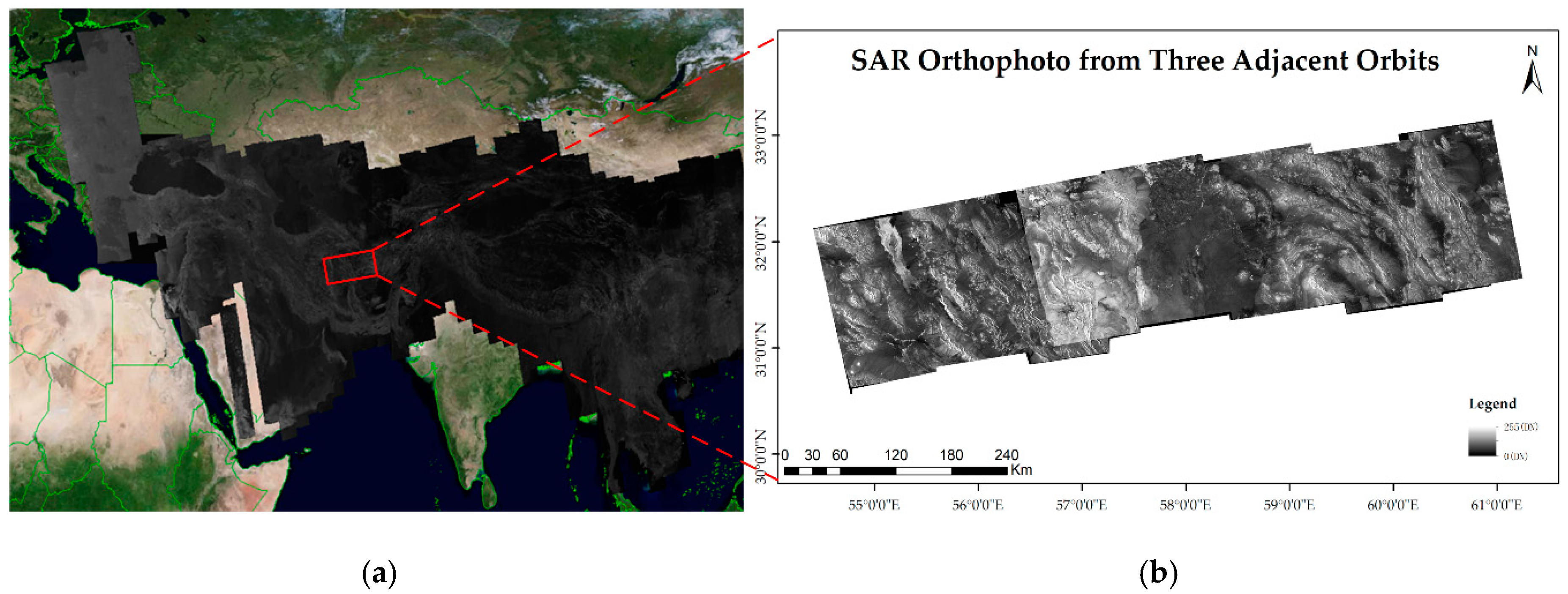

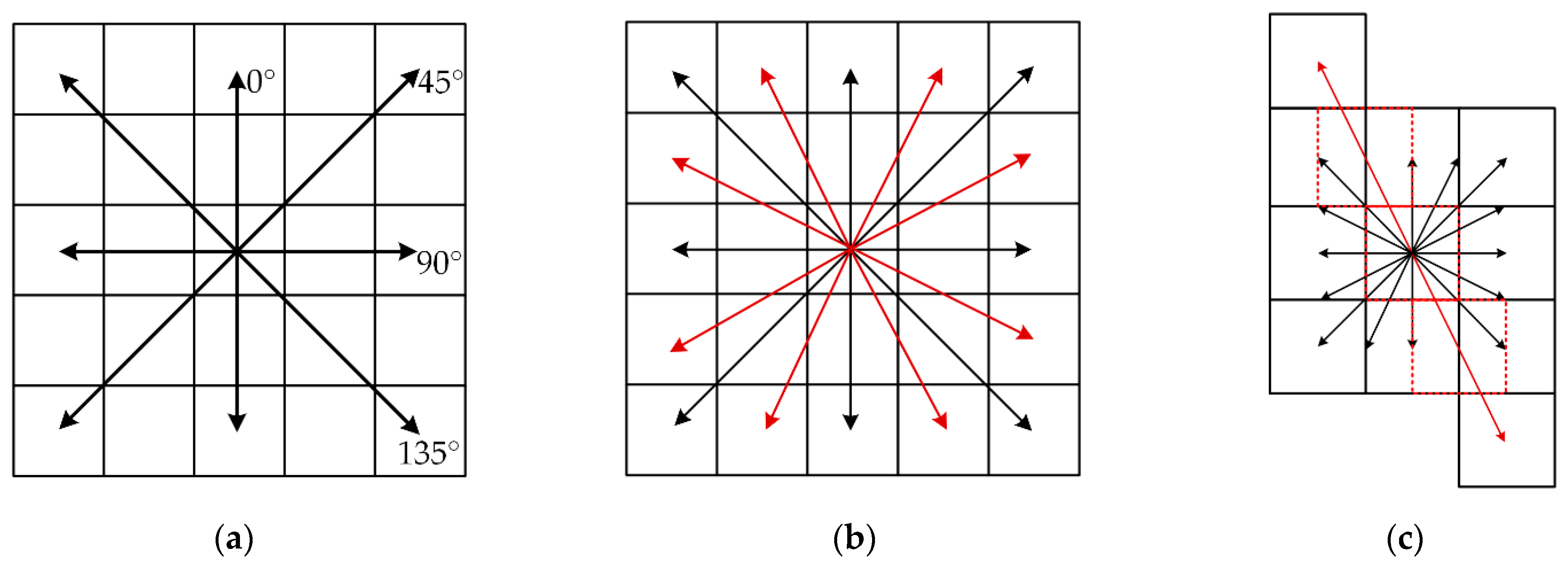

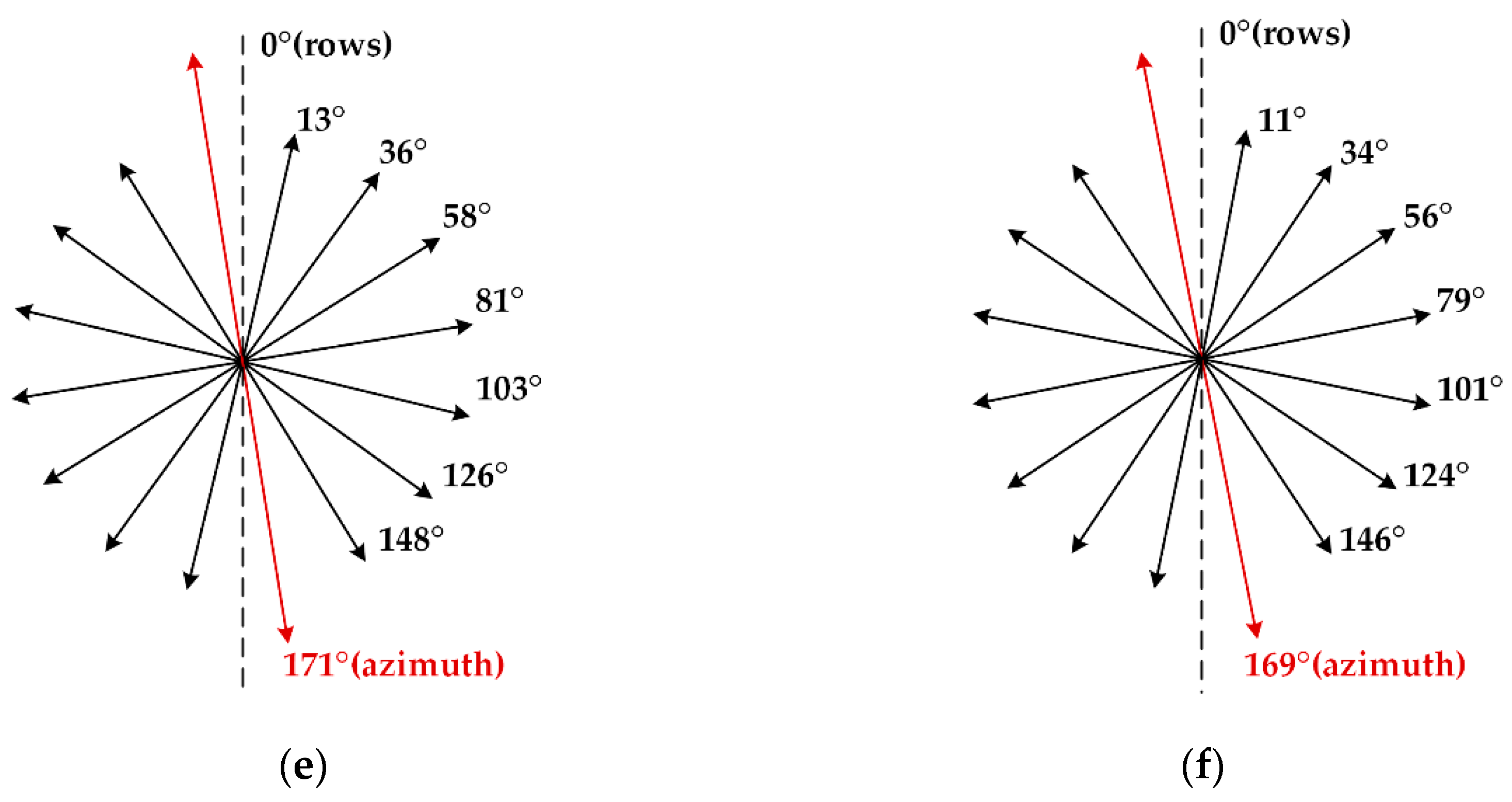



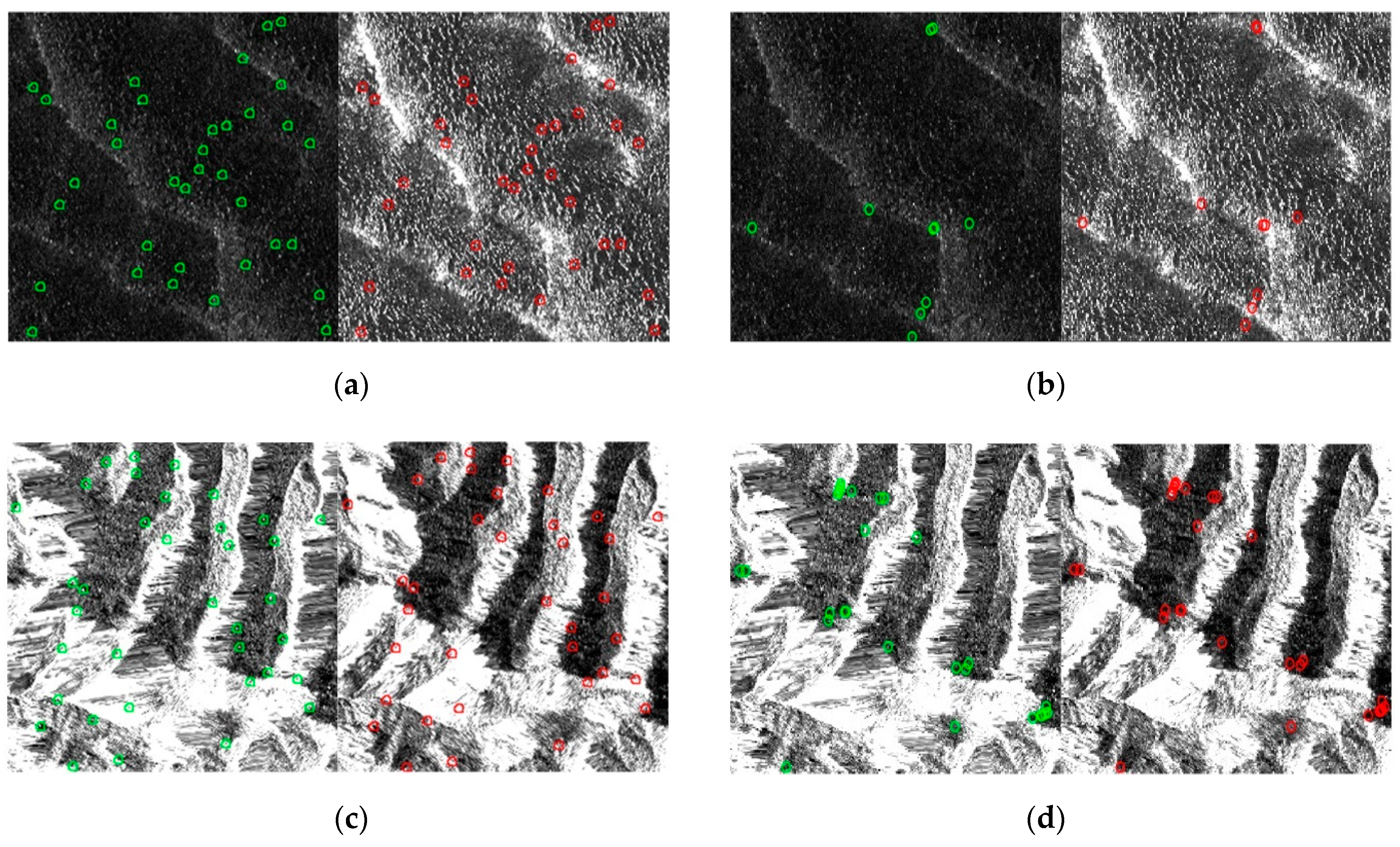


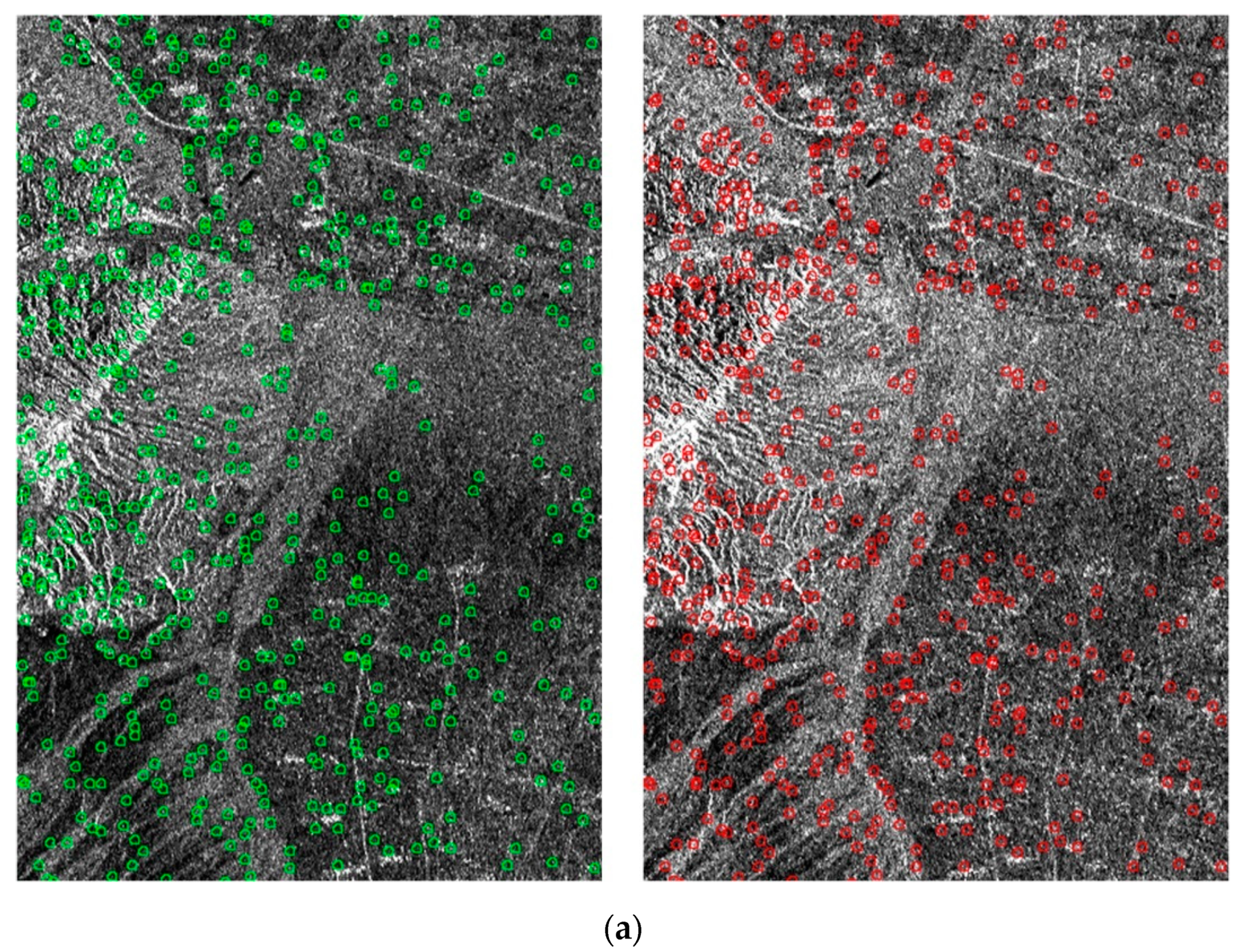
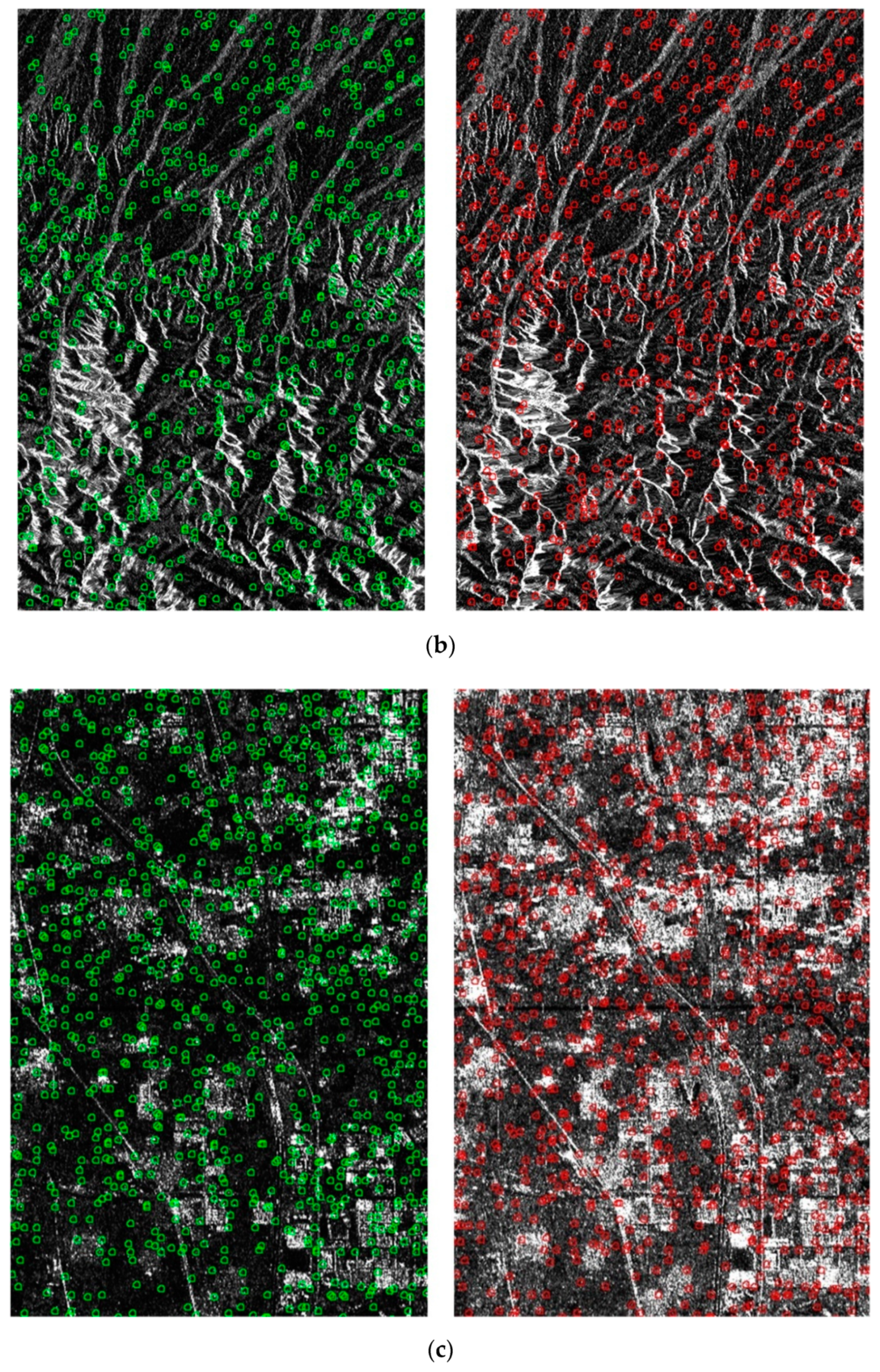
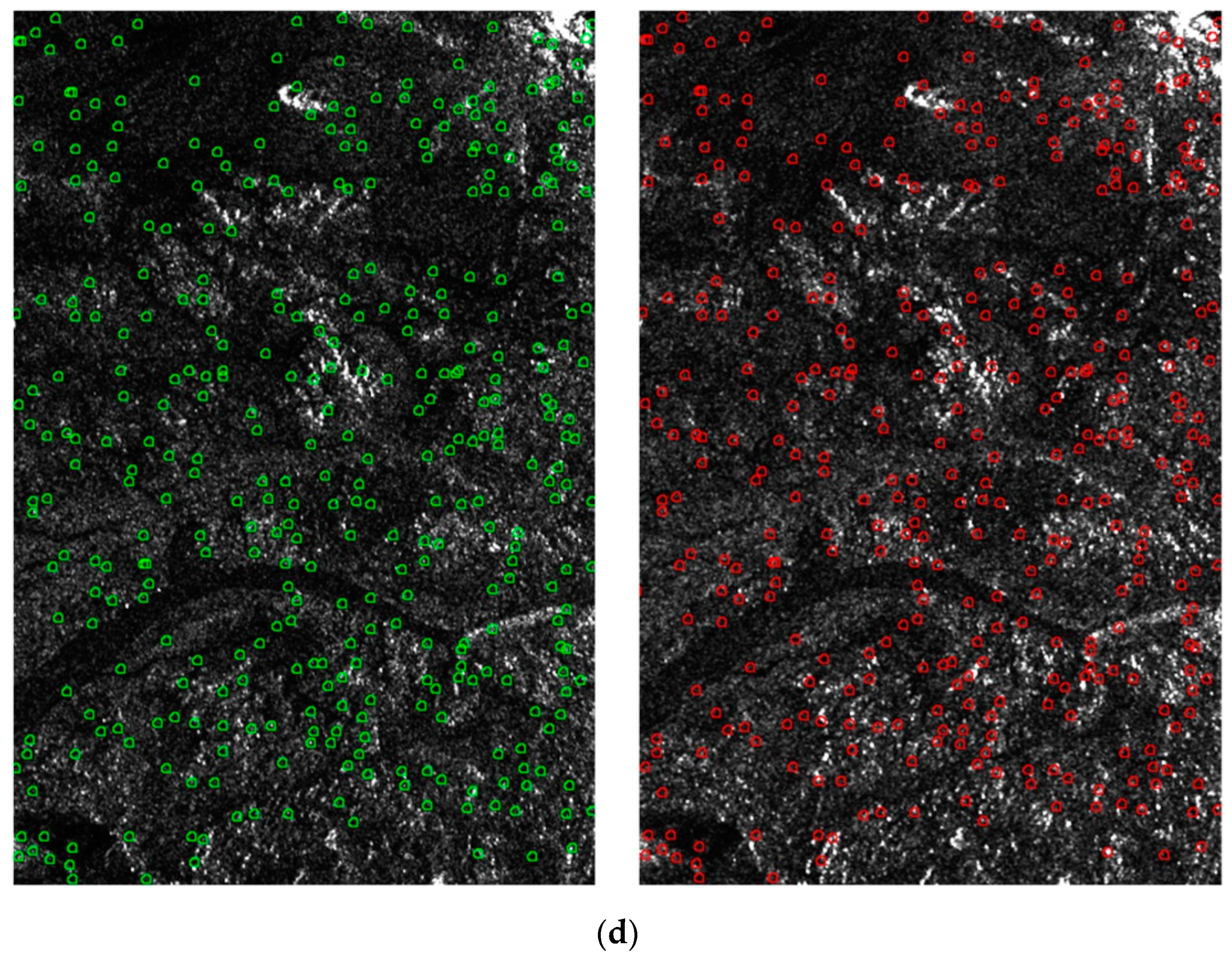
| Data Number | Data Sources | Location | Acquisition Time |
|---|---|---|---|
| Data 1 | Radarsat-2 | Eastern Xinjiang in China | 8 April 2018 and 16 April 2018 |
| Data 2 | Radarsat-2 | Northwestern Heilongjiang in China | 15 April 2018 and 23 March 2018 |
| Data 3 | Sentinal-1A | Northern Ashkhabad in Turkmenistan | 24 March 2018 and 29 March 2018 |
| Data 4 | Sentinel-1A | Western Henan in China | 5 May 2018 and 13 May 2018 |
| Slice | Method | Matches | SD | RMSE | CMR | Time Consuming |
|---|---|---|---|---|---|---|
| Desert Area | SAR-Moravec | 34 | 0.7029 | 1.51 | 0.665 | 1.4168 s |
| SAR-SIFT | 10 | 1.3340 | 2.45 | 0.684 | 5.7932 s | |
| Mountain Area | SAR-Moravec | 47 | 0.5906 | 1.40 | 0.889 | 1.7319 s |
| SAR-SIFT | 31 | 0.8694 | 1.88 | 0.735 | 6.2324 s | |
| Plain Area | SAR-Moravec | 33 | 0.7127 | 1.62 | 0.760 | 1.2056 s |
| SAR-SIFT | 16 | 1.2813 | 2.53 | 0.691 | 5.6482 s | |
| Resident Area | SAR-Moravec | 88 | 0.4671 | 1.13 | 0.911 | 1.7843 s |
| SAR-SIFT | 91 | 0.4514 | 1.12 | 0.873 | 7.1477 s |
| Slice | Matches | SD | RMSE | CMR |
|---|---|---|---|---|
| Desert Area 1 | 55 | 0.6384 | 1.48 | 0.751 |
| Desert Area 2 | 81 | 0.6105 | 1.59 | 0.797 |
| Desert Area 3 | 35 | 0.6953 | 1.65 | 0.728 |
| Mountain Area 1 | 317 | 0.5211 | 1.19 | 0.894 |
| Mountain Area 2 | 292 | 0.5304 | 1.26 | 0.863 |
| Mountain Area 3 | 269 | 0.5268 | 1.21 | 0.881 |
| Plain Area 1 | 132 | 0.5487 | 1.36 | 0.737 |
| Plain Area 2 | 91 | 0.6122 | 1.57 | 0.791 |
| Plain Area 3 | 128 | 0.5826 | 1.46 | 0.774 |
| Resident Area 1 | 274 | 0.4498 | 1.14 | 0.915 |
| Resident Area 2 | 305 | 0.4651 | 1.15 | 0.934 |
| Resident Area 3 | 258 | 0.4102 | 1.10 | 0.911 |
| Image Data | Method | SD | RMSE | CMR | GDD | Time Consuming |
|---|---|---|---|---|---|---|
| Data 1 | 0.5624 | 1.42 | 0.881 | 0.668 | 4 min 16.2 s | |
| 0.5155 | 1.28 | 0.911 | 0.674 | 7 min 3.8 s | ||
| 0.5371 | 1.33 | 0.692 | 0.281 | 33 min 44.5 s | ||
| 0.4467 | 1.21 | 0.915 | 0.705 | 4 min 35.7 s | ||
| Data 2 | 0.6105 | 1.47 | 0.865 | 0.751 | 4 min 49.5 s | |
| 0.5740 | 1.34 | 0.908 | 0.727 | 8 min 20.1 s | ||
| 0.6422 | 1.39 | 0.717 | 0.362 | 37 min 14.6 s | ||
| 0.4638 | 1.22 | 0.923 | 0.783 | 4 min 56.7 s | ||
| Data 3 | 0.6866 | 1.49 | 0.897 | 0.553 | 3 min 22.0 s | |
| 0.6328 | 1.34 | 0.922 | 0.576 | 5 min 13.2 s | ||
| 0.7135 | 1.36 | 0.751 | 0.165 | 26 min 26.8 s | ||
| 0.4704 | 1.24 | 0.925 | 0.592 | 3 min 24.9 s | ||
| Data 4 | 0.6073 | 1.45 | 0.872 | 0.619 | 3 min 39.6 s | |
| 0.5308 | 1.34 | 0.901 | 0.591 | 5 min 45.4 s | ||
| 0.5629 | 1.37 | 0.728 | 0.188 | 29 min 57.2 s | ||
| 0.4891 | 1.28 | 0.904 | 0.660 | 4 min 5.3 s |
© 2020 by the authors. Licensee MDPI, Basel, Switzerland. This article is an open access article distributed under the terms and conditions of the Creative Commons Attribution (CC BY) license (http://creativecommons.org/licenses/by/4.0/).
Share and Cite
Han, C.; Luo, W.; Guo, H.; Ding, Y. An Image Matching Method for SAR Orthophotos from Adjacent Orbits in Large Area Based on SAR-Moravec. Remote Sens. 2020, 12, 2892. https://doi.org/10.3390/rs12182892
Han C, Luo W, Guo H, Ding Y. An Image Matching Method for SAR Orthophotos from Adjacent Orbits in Large Area Based on SAR-Moravec. Remote Sensing. 2020; 12(18):2892. https://doi.org/10.3390/rs12182892
Chicago/Turabian StyleHan, Chunming, Wei Luo, Huadong Guo, and Yixing Ding. 2020. "An Image Matching Method for SAR Orthophotos from Adjacent Orbits in Large Area Based on SAR-Moravec" Remote Sensing 12, no. 18: 2892. https://doi.org/10.3390/rs12182892






